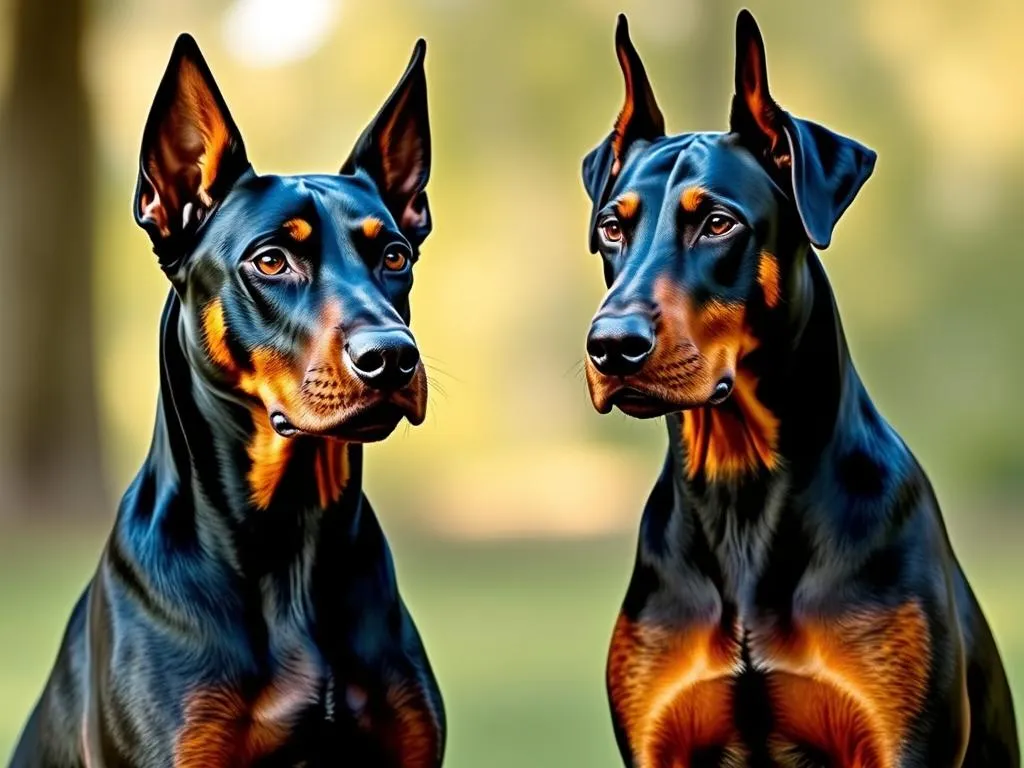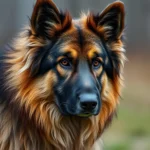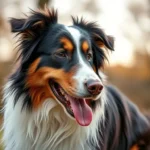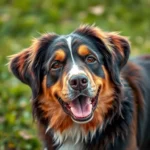
Choosing the right dog breed is a significant decision for any potential dog owner. With so many breeds to consider, understanding their unique characteristics can help narrow down your choices. In this article, we will delve into two remarkable breeds: the German Pinscher and the Doberman. While they share some similarities, their differences can greatly influence which one might be the right fit for your lifestyle.
History and Origin
German Pinscher
The German Pinscher hails from Germany, where it was developed in the 18th century. Originally, this breed served as a versatile farm dog, excelling in tasks such as rat-catching and guarding livestock. Its lineage can be traced back to the Standard Schnauzer, and through selective breeding, the German Pinscher was refined into the elegant, athletic dog we see today. This breed has remained relatively unchanged over the years, maintaining its reputation for intelligence and loyalty.
Doberman
The Doberman was created in the late 1890s by a German tax collector named Karl Friedrich Louis Dobermann. He sought to develop a breed that would serve as a loyal companion and an effective guard dog. The Doberman quickly gained popularity for its protective instincts and intelligence. Recognized by various kennel clubs worldwide, the Doberman became a symbol of loyalty and bravery, often serving in police and military roles.
Physical Characteristics
Size and Build
When comparing the German Pinscher vs Doberman, one of the first things to note is their size.
-
German Pinscher: Typically stands between 17 to 20 inches tall and weighs between 25 to 45 pounds. This breed has a sleek, muscular build that emphasizes agility and speed.
-
Doberman: Generally larger, the Doberman stands between 24 to 28 inches tall and weighs between 60 to 100 pounds. Its robust and athletic body is built for endurance and strength.
Both breeds exhibit a well-proportioned body structure, but the Doberman’s larger size often makes it more imposing.
Coat and Color
Both breeds feature short, smooth coats that are easy to maintain.
-
German Pinscher: The coat can come in various colors, including black, chocolate, and fawn, often with rust markings.
-
Doberman: This breed is most commonly seen in black and tan, blue and tan, red and tan, or fawn and tan.
Grooming needs for both breeds are minimal; however, regular brushing is recommended to manage shedding and keep their coats healthy.
Temperament and Behavior
General Temperament
The temperaments of the German Pinscher and Doberman can vary significantly despite some overlapping traits.
-
German Pinscher: Known for being lively, intelligent, and playful, this breed has a spirited nature that requires regular mental and physical stimulation. They tend to be affectionate with their families but can be wary of strangers.
-
Doberman: Dobermans are known for their loyalty and protective instincts. They are intelligent and eager to please, making them highly trainable. While they can be reserved with strangers, they are incredibly loving with their families.
Socialization and Interaction
Both breeds excel in socialization, but they require different approaches.
-
German Pinscher: Early socialization is crucial to prevent excessive wariness of strangers. Positive reinforcement methods work best, and they typically do well with other pets if introduced properly.
-
Doberman: Dobermans also benefit from early socialization to ensure they grow up to be well-rounded dogs. They tend to exhibit protective behaviors, which can be managed through consistent training and exposure to different environments.
Training and Obedience
Trainability
When comparing the German Pinscher vs Doberman, both breeds showcase high intelligence and trainability.
-
German Pinscher: They are quick learners and respond well to positive reinforcement techniques. However, their independent streak may require patience and a firm hand during training.
-
Doberman: Renowned for their intelligence, Dobermans excel in obedience training. They are eager to learn and respond well to structured training sessions. Consistency and positive reinforcement are key to their success.
Common Training Challenges
While both breeds are trainable, they do present unique challenges.
-
German Pinscher: One challenge is their tendency to become bored quickly, which can lead to mischievous behavior. Keeping training sessions engaging and varied is essential.
-
Doberman: Dobermans can be strong-willed, which may lead to stubbornness during training. Establishing leadership and consistency will help mitigate this challenge.
Health and Lifespan
Common Health Issues
Both breeds are generally healthy but can be prone to certain health issues.
-
German Pinscher: Common health concerns include hip dysplasia, eye disorders, and certain skin conditions. Regular veterinary check-ups can help catch these issues early.
-
Doberman: Dobermans are at risk for dilated cardiomyopathy, hip dysplasia, and von Willebrand’s disease. Regular health screenings can help manage these risks.
Lifespan Expectations
The lifespan of both breeds can vary, but generally:
-
German Pinscher: The average lifespan is about 12 to 15 years.
-
Doberman: Dobermans typically live around 10 to 12 years, though some can live longer with proper care.
Factors such as genetics, diet, and lifestyle can influence longevity for both breeds.
Exercise and Activity Needs
Daily Exercise Requirements
Both breeds require regular exercise, but their needs differ slightly.
-
German Pinscher: They thrive on daily exercise, requiring at least 60 minutes of vigorous activity to keep them mentally and physically stimulated. Activities like running, agility training, and interactive games are ideal.
-
Doberman: Dobermans also need ample exercise, typically around 60 to 90 minutes daily. They enjoy jogging, playing fetch, and participating in obedience training.
Ideal Living Environments
Both breeds require space to roam and play, but their adaptability can vary.
-
German Pinscher: They can adapt well to apartment living if given sufficient exercise and mental stimulation.
-
Doberman: While they can live in an apartment setting, they thrive best in homes with yards where they can run and play freely.
Both breeds can adapt to different climates, but consistent exercise remains crucial for their well-being.
Cost of Ownership
Initial Costs
When considering the German Pinscher vs Doberman, initial costs can vary.
-
German Pinscher: The purchase price typically ranges from $1,500 to $2,500, depending on the breeder and bloodline. Initial setup costs, including bedding, food, and grooming supplies, can add another $300 to $500.
-
Doberman: Dobermans often cost between $2,000 and $3,000. Initial setup costs are similar, ranging from $300 to $500.
Ongoing Expenses
Ongoing expenses for both breeds include food, grooming, and veterinary care.
-
Monthly Food Costs: Expect to spend around $50 to $100 per month for quality dog food, depending on the size and dietary needs.
-
Veterinary Care: Routine veterinary visits can cost an average of $300 to $500 annually, with potential increases for specific health issues.
Insurance considerations are also essential, as this can mitigate unforeseen medical expenses.
Conclusion
In summary, the German Pinscher and Doberman are both exceptional breeds, each with unique characteristics that cater to different owner lifestyles. The German Pinscher is energetic and playful, while the Doberman is known for its loyalty and protective nature. Understanding these differences can help potential dog owners make informed decisions about which breed fits their lifestyle better.
Key Differences
- Size: Dobermans are generally larger than German Pinschers.
- Temperament: German Pinschers are more playful, while Dobermans are protective.
- Trainability: Both breeds are intelligent, but Dobermans tend to be more eager to please.
- Health Issues: Each breed has its common health concerns, which should be carefully considered.
Ultimately, researching both breeds and considering your individual needs and lifestyle will help you make the best choice for your new furry family member.
FAQs
-
Are German Pinschers good family dogs?
Yes, German Pinschers can be excellent family dogs when properly socialized and trained. They are affectionate and loyal but require regular activity and mental stimulation. -
How do Dobermans compare to other guard dogs?
Dobermans are often regarded as one of the best guard dogs due to their loyalty, intelligence, and protective instincts. They are more approachable than some other breeds, which makes them ideal companions as well. -
What are the best training techniques for each breed?
Both breeds respond well to positive reinforcement techniques. Consistency and engagement during training sessions are essential for success. -
How much exercise do German Pinschers need daily?
German Pinschers typically require at least 60 minutes of vigorous exercise daily to stay healthy and happy. -
What are the grooming needs for Dobermans?
Dobermans have low grooming needs, requiring occasional brushing to manage shedding and maintain coat health. Regular nail trimming and dental care are also essential.








